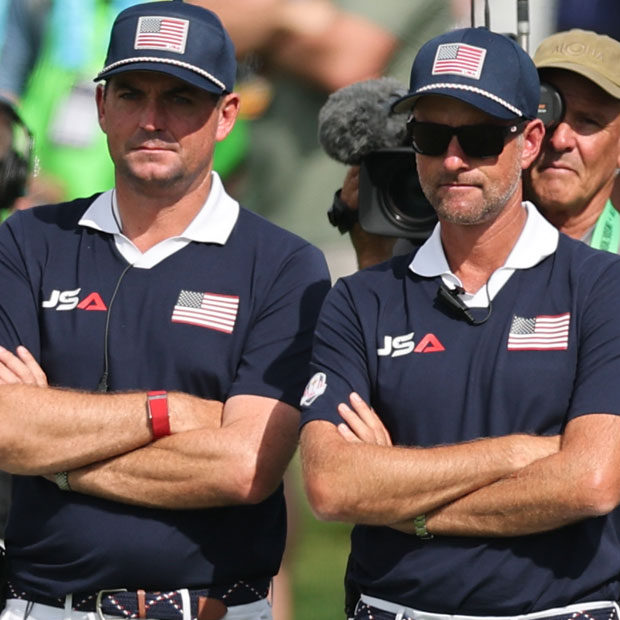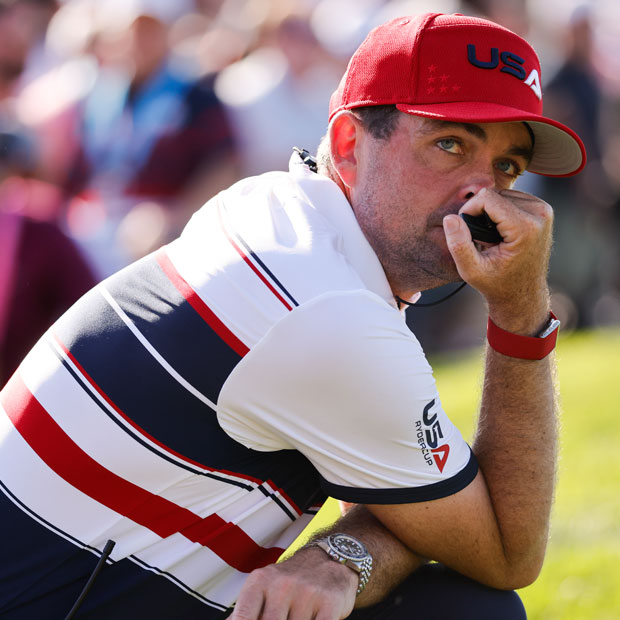Kingsley Club
Kingsley Club offers intricate greens by Mike DeVries and a wonderfully laid-back atmosphere in a majestic Northern Michigan landscape

Building Kingsley Club with Golf Architect Mike DeVries
No bunkers needed: the 12th at Kingsley Club
Minutes south of Traverse City, Michigan, sits one of the country’s finest modern golf courses. Kingsley Club was architect Mike DeVries’s second solo project and served as a springboard for his future work in his home state of Michigan and across the world. At Kingsley, you will find a majestic Northern Michigan landscape, intricate greens, and a wonderfully laid-back atmosphere.
{{content-block-course-profile-kingsley-club-001}}
Take Note…
Secret sauce. If you look in the rock wall alongside the 18th tee, you will find a whiskey surprise. Take a shot before you play the exhilarating finisher.
All about golf. This club doesn’t suffer from an identity crisis. It’s a place to play golf. The clubhouse is a double-wide trailer, the range is bare-bones, and the pro shop is small. It’s all about the golf course and the enjoyment of the game here.
Need for speed. Kingsley is one of the few courses in the United States that maintains an all-fescue playing surface. This means lots of bouncing and rolling, so be ready for your ball not to stop where it lands.
Favorite Hole
No. 3, par 4, 287-426 yards
A tone-setting hole with several options off the tee. You are welcome either to go for broke with driver or to lay back with an iron. The fairway is wide, but the right half cascades down, leaving players on that side with an obscured shot from an uneven lie into a green that angles from left to right. The left portion of the fairway is ideal because the lie is level and the angle into the green is ideal. Hitting your tee shot there is dangerous, though, because of the course’s boundary. The front portion of the green sits up before tumbling down with the natural topography in the back.
Favorite Hole
No. 3, par 4, 287-426 yards
A tone-setting hole with several options off the tee. You are welcome either to go for broke with driver or to lay back with an iron. The fairway is wide, but the right half cascades down, leaving players on that side with an obscured shot from an uneven lie into a green that angles from left to right. The left portion of the fairway is ideal because the lie is level and the angle into the green is ideal. Hitting your tee shot there is dangerous, though, because of the course’s boundary. The front portion of the green sits up before tumbling down with the natural topography in the back.

{{content-block-course-profile-kingsley-club-002}}
Overall Thoughts
Many developers and architects like to use the term “minimalist” for their golf courses. At Kingsley, it’s actually an apt description. On a sandy, rollicking property, architect Mike DeVries moved a mere 30,000 cubic yards of earth to create one of the most fun golf courses in America. That fun factor comes from a combination of stunning topography, clever design, and firm fescue turf.
One of the benefits of moving very little earth on a unique property is that you will have a one-of-a-kind golf course. The course traverses two distinct types of Northern Michigan land: open, rolling meadow and dense woods. Along the way, you play over and around incredible landforms. No two hole feels similar because of the abruptness and variety of terrain that Mike DeVries was given.
The start of the round sets the stage for what’s to come. The first six holes traverse some wild land and represent one of Kingsley’s most significnt strengths: how DeVries draped fairways over bold features massive land forms, creating a wide range of outcomes for shots.
The fourth hole, for example, is a par 4 playing over a big hog’s back. A perfect tee shot directly down the middle will yield a look at the half-punchbowl green. The farther you lay back, the wider this center-fairway feature is. The farther you push up, the more it narrows. Missing the hog’s back either right or left will send your ball tumbling down the side of the fairway, likely resulting in an uneven lie and a partially or fully blind view of the green. So if you want to get aggressive off the tee, you have to walk the plank. Many other architects would have moved earth to make this landform more forgiving, or bypassed it under the assumption that it was too severe for a fairway. The boldness of DeVries’s vision and his respect for the natural qualities of the site instead produced a thrilling tee shot that has you questioning your strategy.

Compared to many modern designs, Kingsley is unusually ferocious. It tosses ill-advised or ill-executed shots to yonder with an unabashed attitude. A few greens—especially Nos. 2, 8, 9, and 15—are punishing and extraordinarily difficult to hit. Some golfers may find these too extreme or unfair. But aside from the 15th, all of these greens are on holes that allow for short approaches. Kingsley is not randomly cruel. It just doesn’t hand you a low score unless you play with precision and intelligence.
I like when a course reveals more of itself with every play. The first time I played Kingsley, I became frustrated on the front nine. Shots I hit straight at flags often ended up in undesirable locations. The speed of the turf, green contours, and wild terrain punched me in the face. My initial reaction was annoyance, which I think is common for first-timers at Kingsley. For nine holes, I fell victim to the disease of believing that the correct shot is always the one directly at the obvious target. But at the turn, I regrouped and started looking more closely at the course and approaching it more creatively. I began to have fun. The next time I visited, I enjoyed myself even more.
Aiming at your ultimate target isn’t always the correct strategy at Kingsley. It’s paramount to understand what the contours will do to your ball after it lands. The only way to discover these intricacies and different routes of attack and recovery is to play the course more than once. To me, that’s one of the best qualities that any golf course, whether private or municipal, can have. An opportunity for discovery that keeps you coming back to learn and master more.
2 Eggs
I hemmed and hawed over this rating for a while, debating between two and three Eggs. Ultimately, I do have a couple of design-related nitpicks; I don’t love the seventh and 17th tee shots, for instance. However, one of the best compliments you can give a golf course is that it knows what it is, and Kingsley knows exactly what it is. For a true golf nut, there aren’t many better places to spend a day.
Additional Content
No Bunkers Needed: The 12th at Kingsley Club (article)
Course Tour

{{content-block-course-profile-kingsley-club-003}}
Building Kingsley Club with Golf Architect Mike DeVries
Leave a comment or start a discussion
Get full access to exclusive benefits from Fried Egg Golf
- Member-only content
- Community discussions forums
- Member-only experiences and early access to events











Leave a comment or start a discussion
Lorem ipsum dolor sit amet, consectetur adipiscing elit. Suspendisse varius enim in eros elementum tristique. Duis cursus, mi quis viverra ornare, eros dolor interdum nulla, ut commodo diam libero vitae erat. Aenean faucibus nibh et justo cursus id rutrum lorem imperdiet. Nunc ut sem vitae risus tristique posuere. uis cursus, mi quis viverra ornare, eros dolor interdum nulla, ut commodo diam libero vitae erat. Aenean faucibus nibh et justo cursus id rutrum lorem imperdiet. Nunc ut sem vitae risus tristique posuere.